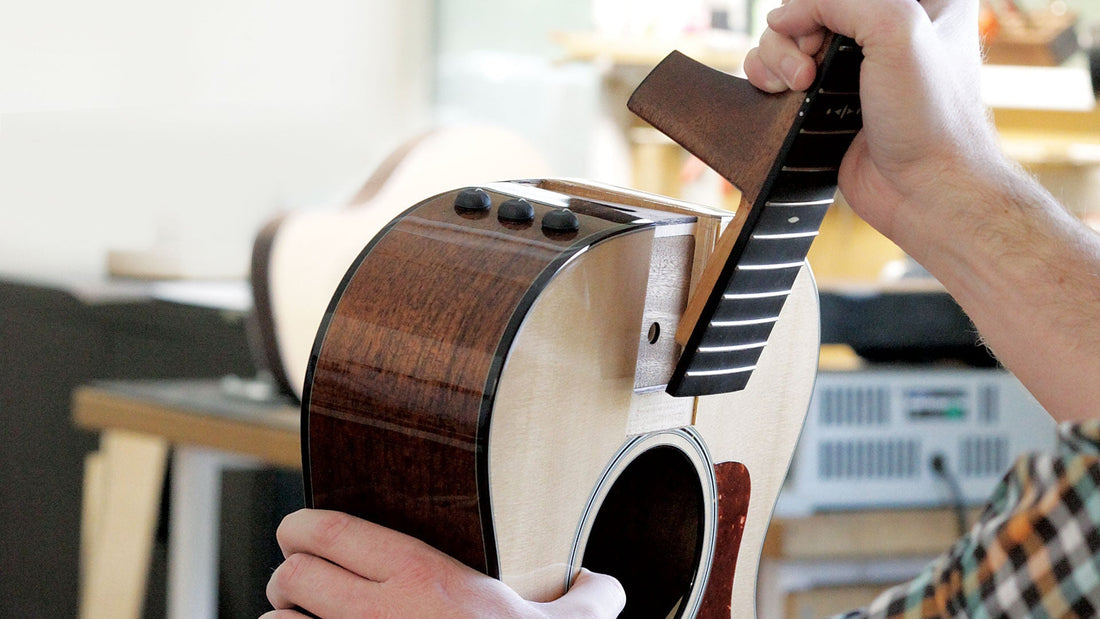
Understanding Guitar Neck Angle: What Every Player Should Know
Share
Understanding Guitar Neck Angle: What Every Player Should Know
When it comes to guitar design, few topics spark as much quiet controversy—and confusion—as neck angle. While often overshadowed by debates around tonewoods, pickups, or finishes, the angle of the neck in relation to the body is foundational to a guitar’s playability, tone, and long-term setup stability. Whether you're buying your first guitar or investing in a high-end acoustic or electric, understanding neck angle and its relationship to neck joint construction is essential.
What Is Neck Angle and Why It Matters
The neck angle of a guitar refers to the angle at which the neck is set relative to the body. This angle directly affects string height (action), intonation, and how well a guitar plays or sounds. An incorrect neck angle can lead to poor action, buzzing, difficulty in setup, or loss of tone and sustain.
Neck Joint Types and Their Impact
Acoustic Guitar Neck Joints
Most acoustic guitars feature glued-in neck joints, often in the form of a dovetail with the fretboard glued to the soundboard. Classical guitars have traditionally used a "Spanish heel," where the neck heel is integrated into the sides of the guitar. Though bolt-on necks have historically been less common in acoustics, innovations have led to broader acceptance—even by brands like Martin Guitars.
Electric Guitar Neck Joints
Electric guitars typically use one of three neck joint types:
-
Bolt-on: Popularized by Fender, these necks are screwed into the body, making them easier to produce and repair.
-
Set neck (glued-in): Used by Gibson and others, this method offers a more seamless feel and is believed by many to enhance sustain.
-
Neck-through: The neck extends through the entire body. Rare outside of high-performance guitars (e.g., shred or metal instruments), this method offers excellent stability but is costly and difficult to repair.
Adjustability and Repair Considerations
Bolt-on necks are often easier to adjust or replace, making them more repair-friendly. If a neck angle is off or shifts over time, a bolt-on design can be reset or shimmed easily. Glued-in necks require complex procedures like neck resets, which are labor-intensive and expensive.
Innovations in Neck Adjustment
Because acoustic guitars have less adjustability than electrics, manufacturers have worked to innovate in this area:
-
Taylor Guitars introduced a proprietary shim-based bolt-on neck joint in the 1990s.
-
More recently, Taylor's CEO Andy Powers developed the Action Control Neck, which allows real-time neck angle adjustments without removing the neck or using shims.
-
Furch Guitars of the Czech Republic also offers a user-adjustable neck angle system.
Other examples include:
-
Riversong Guitars: Uses a full-body truss system that allows adjustment from the tailblock.
-
Fender Micro-Tilt (1970s): Features a small bolt to change neck angle on bolt-on designs.
Even with electric guitars' bridge adjustability, the neck angle remains vital for achieving proper playability and tone.
How Neck Angle Affects Tone and Playability
Many guitarists, especially vintage gear lovers, have noted the importance of bridge height and neck angle. Joe Walsh of The Eagles once described a quarter-inch bridge gap on a 1950s Les Paul as critical to great sound—not just for playability, but for tonal richness.
The angle impacts:
-
Sustain: A better neck angle may improve string transfer and resonance.
-
Pickup proximity: Closer strings result in a stronger signal.
-
Playability: Poor angles can raise or lower action beyond usable limits.
What Happens When Neck Angle Is Incorrect
Imagine drawing a straight line from the neck out across the body:
-
If the neck angle is too shallow, the bridge must be raised too high, pulling strings far from pickups and affecting playability.
-
If the neck angle is too steep, the bridge may need to be lowered more than possible, limiting action and tone.
Both scenarios lead to issues with setup, sustain, and tone. Limits in bridge and pickup adjustment mean neck angle must be within an ideal range to ensure optimal performance.
Final Thoughts: What Guitar Buyers Should Look For
Neck angle is one of the most fundamental aspects of a guitar's construction. Yet it’s often overlooked by buyers drawn to finish, color, or branding. Understanding neck angle helps players avoid future problems and choose instruments that will perform well for years to come.
Whether you're buying a $500 guitar or a $5,000 one, don’t ignore the geometry. Ask about the neck joint. Check bridge height. Look for adjustability. Because when it comes to playability and tone, neck angle matters more than you might think.
